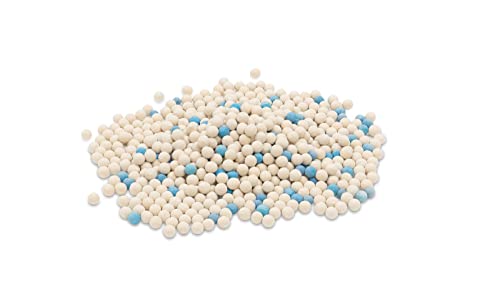




Molecular sieves are porous materials with a highly ordered structure that can separate molecules by size and shape. They are widely used in various industries due to their unique ability to absorb and adsorb different substances.
One of the main functions of molecular sieves is to remove moisture from gases and liquids. Their porous structure allows them to selectively capture water molecules, preventing them from contaminating the desired product. This makes molecular sieves essential in dehydration processes across industries such as natural gas production, petrochemical refining, and air separation.
In addition to moisture removal, molecular sieves are also used for gas separation. Different molecules have different sizes and shapes, and molecular sieves can exploit these differences to selectively absorb certain gases while allowing others to pass through. This enables the separation of mixture components, such as nitrogen from oxygen in air, or the removal of carbon dioxide from natural gas.
Molecular sieves are also employed in the purification of liquids and solvents. By selectively adsorbing impurities, such as water, organic contaminants, or sulfur compounds, they can improve the quality and purity of various liquids, including chemicals, pharmaceuticals, and fuels.
In summary, the function of molecular sieves lies in their ability to selectively absorb or adsorb specific molecules based on their size and shape. Whether it’s removing moisture, separating gases, or purifying liquids, molecular sieves play a vital role in a wide range of industrial applications.
Understanding the Function
Molecular sieves are highly versatile materials that have a wide range of applications. Their function is based on their unique ability to selectively adsorb certain molecules while excluding others. This property is due to their porous structure, which allows them to act as molecular filters.
When a gas or liquid mixture comes into contact with a molecular sieve, the smaller molecules are able to enter the pores of the sieve, while the larger molecules are effectively blocked. This size-based selectivity is what makes molecular sieves so useful in various industrial processes.
1. Adsorption
One of the main functions of molecular sieves is adsorption. They can adsorb a wide range of molecules, including water, gases, and organic compounds. This ability to trap and hold molecules is exploited in various applications such as gas drying, air separation, and purification processes.
For example, in natural gas processing, molecular sieves can effectively remove water vapor and other impurities, ensuring the purity and quality of the gas. Similarly, in the production of oxygen from air, molecular sieves play a crucial role in separating nitrogen and other trace gases.
2. Dehydration
Another important function of molecular sieves is dehydration. Due to their ability to selectively adsorb water molecules, they are commonly used in drying processes. They can effectively remove water from liquids or gases, thereby preventing spoilage, corrosion, and other undesirable effects.
Molecular sieves find extensive application in the food and beverage industry, where they are used to dry various products such as powdered milk, beer, and pharmaceuticals. They are also used in the production of synthetic materials, such as plastics and polymers, where the presence of water can affect the quality and properties of the final product.
In conclusion, molecular sieves are essential in various industries due to their unique function of selective adsorption and dehydration. Their porous structure allows them to act as molecular filters, enabling the separation and purification of gases and liquids. Understanding their function is crucial in harnessing their full potential for industrial applications.
What are Molecular Sieves?
Molecular sieves are highly adsorbent materials used in various industries and applications. They are crystalline aluminosilicates with uniform pores and have a high internal surface area. These materials have the ability to adsorb molecules based on their size and polarity.
One of the main functions of molecular sieves is to selectively adsorb certain molecules from a mixture. They can separate gases and liquids by adsorbing specific molecules while allowing others to pass through. This property makes them ideal for various purification processes.
Molecular sieves are widely used in the petrochemical industry for the purification of natural gas and preservation of stored hydrocarbons. They can remove impurities such as water, carbon dioxide, and sulfur compounds from gas streams, ensuring the quality and safety of the final product.
They are also used in the pharmaceutical industry for the purification and drying of solvents, as well as in the production of antibiotic and vitamin formulations. Molecular sieves help remove water and other impurities from solvents, improving the quality and stability of pharmaceutical products.
Additionally, molecular sieves are used in the automotive industry for the drying of refrigerants in air conditioning systems. They help remove moisture and other contaminants from the refrigerant, preventing damage to the system and ensuring its optimal performance.
In conclusion, molecular sieves play a crucial role in various industries and applications. Their unique adsorption properties make them valuable for the purification and separation of substances, ensuring the efficiency and quality of many processes and products.
Applications in Various Industries
Molecular sieves have a wide range of applications in various industries due to their unique properties. These industries include:
| Industry | Application |
|---|---|
| Oil and Gas | Molecular sieves are used for natural gas dehydration, removal of sulfur compounds, and purification of various hydrocarbon streams. |
| Petrochemical | They are used for the separation and purification of chemical feedstocks, removal of impurities from the process streams, and drying of solvents. |
| Pharmaceutical | Molecular sieves are employed for the drying and purification of pharmaceutical intermediates and active pharmaceutical ingredients (APIs). |
| Automotive | They are used in the automotive industry for the drying of refrigerants, removal of moisture from air conditioning systems, and reduction of hydrocarbon emissions. |
| Electronics | Molecular sieves are essential for removing moisture from the manufacturing process of electronic devices, such as semiconductors and optical fibers. |
| Food and Beverage | They are used for the removal of moisture and impurities in food and beverage production, thereby extending the shelf life of products. |
These are just a few examples of the extensive applications of molecular sieves in various industries. Their versatility and efficiency make them invaluable in many processes where selective adsorption and purification are crucial.
Function in Gas Separation
Molecular sieves play a crucial role in gas separation processes by selectively adsorbing certain gases while allowing others to pass through. This ability is primarily due to their unique structure and pore size distribution.
Adsorption
Molecular sieves are highly porous materials with a complex network of interconnected channels and cavities. These pores have a specific size and shape, allowing them to selectively trap molecules of a certain size or shape. When a gas mixture is passed through the molecular sieve, the smaller molecules can easily diffuse into the pores and be adsorbed, while the larger molecules are excluded and pass through.
Size Exclusion
The size exclusion property of molecular sieves makes them particularly useful for separating gases based on their molecular size. For example, in the production of nitrogen gas from air, a molecular sieve can be used to remove oxygen and other smaller molecules, leaving behind a pure nitrogen stream. Similarly, they can be used to separate hydrocarbons of different sizes, such as separating methane from ethane or propane.
Adsorption Selectivity
Molecular sieves also exhibit different adsorption selectivities for different gases. This selectivity is based on the affinity of the gas molecules for the internal surfaces of the sieve and the interactions between the gas molecules and the sieve’s pores. For example, a molecular sieve may preferentially adsorb water molecules over other gases, making it useful for drying or dehumidifying gas streams.
Overall, molecular sieves are essential in gas separation processes as they provide a means to selectively separate and purify gases based on their size and adsorption properties.
Function in Drying and Purification
Molecular sieves play a crucial role in the process of drying and purification. Due to their unique properties, they are widely used in various industries for removing moisture and impurities from liquids and gases.
Drying Function:
One of the primary functions of molecular sieves is to absorb moisture and water vapor from the surrounding environment. They are highly effective in this process due to their ability to selectively adsorb water molecules while allowing other gases to pass through. This makes them ideal for drying applications, such as in the production of compressed air, natural gas, and pharmaceuticals.
Purification Function:
In addition to drying, molecular sieves also excel at purifying liquids and gases by selectively adsorbing impurities and contaminants. They can effectively remove a wide range of substances, including volatile organic compounds (VOCs), sulfur compounds, and carbon dioxide. This purification process is essential in industries such as petrochemicals, oil refining, and food and beverage production.
How Molecular Sieves Work
Molecular sieves consist of tiny pores with a specific pore size, allowing only molecules smaller than the pore diameter to pass through. As a result, larger molecules and contaminants are selectively adsorbed and trapped, leaving behind a purified substance.
The adsorption capacity and selectivity of molecular sieves can be tailored by modifying the pore structure and composition. This allows for customized solutions to meet specific drying and purification requirements.
Advantages and Limitations
Molecular sieves offer several advantages in various applications:
1. Selectivity
Molecular sieves can be tailored to have specific pore sizes, allowing them to selectively adsorb certain molecules while excluding others. This selectivity makes them highly effective in applications such as gas separation and purification.
2. Capacity
Due to their well-defined porous structure, molecular sieves have a high capacity for adsorption. They can effectively remove a wide range of impurities from liquids and gases, making them useful in industries such as oil refining and natural gas processing.
3. Stability
Molecular sieves are stable and can withstand high temperatures and corrosive environments. This stability allows them to be used in a variety of industrial processes without significant degradation.
However, molecular sieves also have some limitations:
1. Regeneration
Once molecular sieves become saturated with adsorbed molecules, they need to be regenerated to restore their adsorption capacity. This process typically involves heating the sieves or subjecting them to a vacuum, which can be time-consuming and require additional energy.
2. Water Sensitivity
Most molecular sieves are sensitive to water and can lose their adsorption properties in the presence of moisture. This limitation restricts their use in certain applications where moisture removal is essential.
Despite these limitations, molecular sieves continue to be widely used in various industries due to their unique adsorption capabilities and versatile nature.







